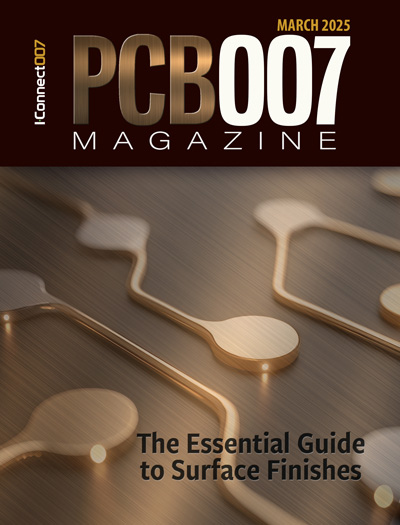-

- News
- Books
Featured Books
- pcb007 Magazine
Latest Issues
Current Issue
In Pursuit of Perfection: Defect Reduction
For bare PCB board fabrication, defect reduction is a critical aspect of a company's bottom line profitability. In this issue, we examine how imaging, etching, and plating processes can provide information and insight into reducing defects and increasing yields.

Voices of the Industry
We take the pulse of the PCB industry by sharing insights from leading fabricators and suppliers in this month's issue. We've gathered their thoughts on the new U.S. administration, spending, the war in Ukraine, and their most pressing needs. It’s an eye-opening and enlightening look behind the curtain.

The Essential Guide to Surface Finishes
We go back to basics this month with a recount of a little history, and look forward to addressing the many challenges that high density, high frequency, adhesion, SI, and corrosion concerns for harsh environments bring to the fore. We compare and contrast surface finishes by type and application, take a hard look at the many iterations of gold plating, and address palladium as a surface finish.
- Articles
- Columns
Search Console
- Links
- Media kit
||| MENU - pcb007 Magazine
3DEM Modeling: Influence of Metal Plating on PCB Channel Loss and Impedance
March 21, 2019 | Chang Fei Yee, Keysight TechnologiesEstimated reading time: 1 minute
This article briefly introduces different types of metal plating commonly used in PCB fabrication. Subsequently, the influence of metal plating on PCB channel loss (i.e., insertion loss or S21) and impedance (i.e., time domain reflectometry or TDR) is studied with 3DEM modeling using Keysight EMPro.
Introduction
Metal plating that serves as a protective layer is applied on top of the copper traces during PCB fabrication, thus alleviating the oxidation process of the copper. Common finishes include immersion silver (IAg), electroless nickel immersion gold (ENIG), etc. With immersion silver, nearly pure silver (i.e., ~0.02 mils in thickness) is coated over the copper traces on a PCB. Meanwhile, with ENIG, nickel (i.e., ~0.2 mils in thickness) is deposited on the copper trace followed by a coating of gold (i.e., ~0.01 mils in thickness) on top. Nickel serves as a barrier layer to prevent the migration of gold into the base copper.
However, metal plating comes with disadvantages. On a PCB, the current of the signal tends to propagate more closely to the surface of the trace when the frequency of the signal becomes higher. Skin depth is the parameter that determines how extensive the current of signal travels with reference to the surface of the transmission channel. The relationship between skin depth and signal frequency is governed by Equation 1. For instance, at frequency 10 GHz, skin depth becomes 0.026 mils.
Equations 2, 3, and 4 indicate that attenuation of the signal is inversely proportional to the metal conductivity. Once metal with lower conductivity is coated over a copper trace, the signal experiences a larger amount of attenuation. For instance, skin depth becomes 0.026 mils at a signal frequency of 10 GHz. If ENIG plating (i.e., base copper 1.09 mils, nickel 0.2 mils in the mid layer, and gold 0.01 mils on top) is applied, the high-frequency signal will propagate on the gold and nickel-plated layers. This signal will encounter a larger magnitude of attenuation due to the lower conductivity of nickel.
To read this entire article, which appeared in the February 2019 issue of Design007 Magazine, click here.
Suggested Items
RF PCB Design Tips and Tricks
05/08/2025 | Cherie Litson, EPTAC MIT CID/CID+There are many great books, videos, and information online about designing PCBs for RF circuits. A few of my favorite RF sources are Hans Rosenberg, Stephen Chavez, and Rick Hartley, but there are many more. These PCB design engineers have a very good perspective on what it takes to take an RF design from schematic concept to PCB layout.
Trouble in Your Tank: Causes of Plating Voids, Pre-electroless Copper
05/09/2025 | Michael Carano -- Column: Trouble in Your TankIn the business of printed circuit fabrication, yield-reducing and costly defects can easily catch even the most seasoned engineers and production personnel off guard. In this month’s column, I’ll investigate copper plating voids with their genesis in the pre-plating process steps.
Elephantech: For a Greener Tomorrow
04/16/2025 | Marcy LaRont, PCB007 MagazineNobuhiko Okamoto is the global sales and marketing manager for Elephantech Inc., a Japanese startup with a vision to make electronics more sustainable. The company is developing a metal inkjet technology that can print directly on the substrate and then give it a copper thickness by plating. In this interview, he discusses this novel technology's environmental advantages, as well as its potential benefits for the PCB manufacturing and semiconductor packaging segments.
Trouble in Your Tank: Organic Addition Agents in Electrolytic Copper Plating
04/15/2025 | Michael Carano -- Column: Trouble in Your TankThere are numerous factors at play in the science of electroplating or, as most often called, electrolytic plating. One critical element is the use of organic addition agents and their role in copper plating. The function and use of these chemical compounds will be explored in more detail.
IDTechEx Highlights Recyclable Materials for PCBs
04/10/2025 | IDTechExConventional printed circuit board (PCB) manufacturing is wasteful, harmful to the environment and energy intensive. This can be mitigated by the implementation of new recyclable materials and technologies, which have the potential to revolutionize electronics manufacturing.


